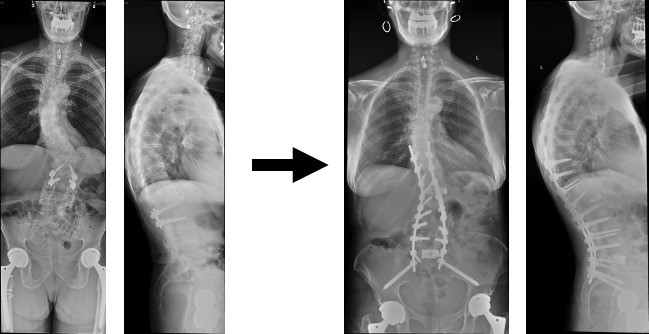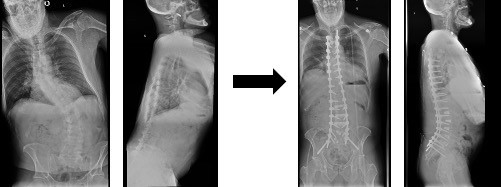<< Back
Why It’s Easier Now to Avoid Traditional Spine Surgery
![]()
March 29, 2021
The 62-year-old woman had contended with scoliosis, or curvature of the spine, her whole life. It kept getting worse despite surgery after surgery. (See Image 1 below.)
Often, when surgeons address one curving part of the spine by fusing vertebrae together to hold them straight, the disease simply migrates to another section of spine, causing it to curve. The result can be pain and trouble moving. This was the case for another patient, whose spine bent so severely his lower ribs rubbed his pelvis. (See Image 2 below.)
These are the challenges Dr. Vijay Yanamadala enjoys. Dr. Yanamadala, medical director of spine quality and surgical optimization at Hartford HealthCare and part the Ayer Neuroscience Institute Spine Wellness Center team, has earned awards for improving the safety and effectiveness of spine surgery.
 Image 1
Image 1
“There is no greater reward than helping someone live their life more fully again,” he said of the work.
But he will quickly point out that surgery – as advanced and adept as he is with the latest technology and minimally-invasive procedures – is the last thing he recommends to patients. The Spine Wellness Center, he said, offers a complete array of nonsurgical options from physical therapy to pain block injections and lifestyle coaching. He generally encourages patients to try one or more first.
“The best spine surgery is no spine surgery,” Dr. Yanamadala said.
The cause of scoliosis is not fully understood, but he sees many adults coming in after decades of struggles. While surgical options existed 30 years ago when they were young, the rate of resulting paralysis was 25 percent to 50 percent, so many opted not to have the procedure. Today, Dr. Yanamadala said advances in technique and technology caused the rate to drop to less than .1 percent.
“We now have tools like spinal navigation, intraoperative CT scanning and neuromonitoring, interoperative tools that allow us more accuracy when working on the spine than ever before,” he said.
Dr. Yanamadala – who earned a bachelor’s and medical degree from Harvard and completed fellowships in minimally-invasive spine surgery at Massachusetts General Hospital and complex spine surgery and spinal deformities at Virginia Mason Medical Center – specializes in treating advanced deformities. Besides scoliosis, that includes reconstructive surgery, cervical myopathy, failed back syndrome, spine trauma, tumors and spinal vascular disease.
“The goal is always optimizing patient outcomes and avoiding unnecessary surgery,” he said.
 Image 2
Image 2
Another common issue is disc damage often caused by arthritis. A 73-year-old patient, Dr. Yanamadala said, had bulging discs pressing tightly against nerves, almost crushing them. He had tried many options, including physical therapy, chiropractic care, acupuncture and injections, but nothing worked. Surgery was the best option in his case, but advanced microsurgery guided by a powerful microscope made the experience better for the patient.
“Traditional surgery would have meant a six- to eight-inch scar and a long recovery,” Dr. Yanamadala said. “Using the microscope, I was able to decompress the discs through three small incisions in a two-hour procedure. He went home the same day, just three hours after surgery. We are able to be much more efficient so we do no more and no less than is needed.”